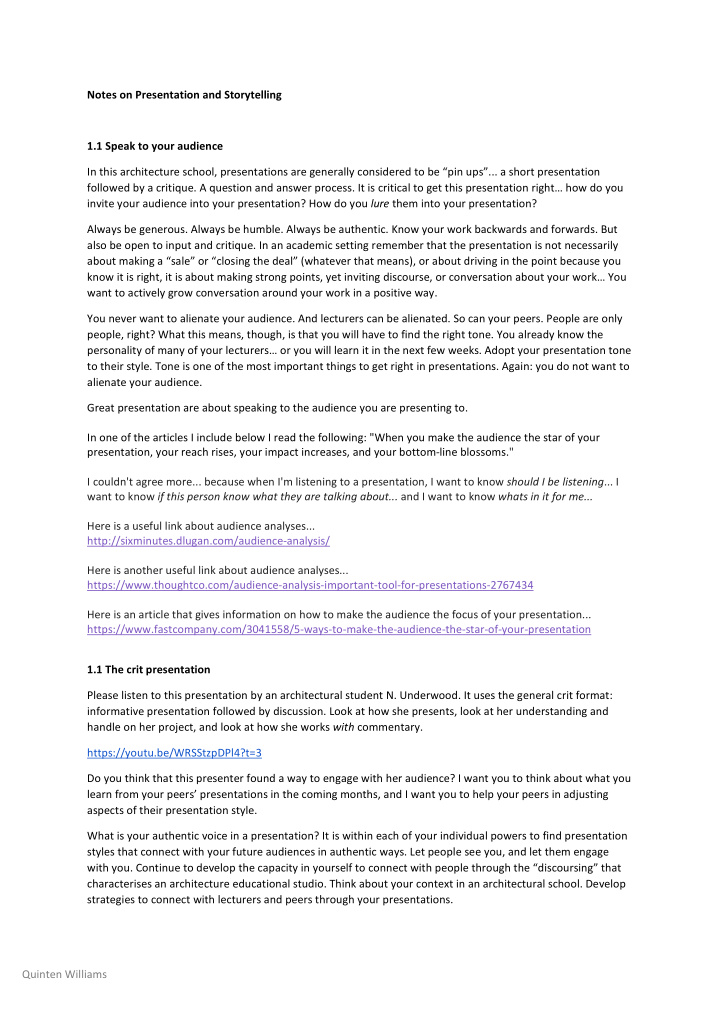



Notes on Presentation and Storytelling 1.1 Speak to your audience In this architecture school, presentations are generally considered to be “pin ups”... a short presentation followed by a critique. A question and answer process. It is critical to get this presentation right… how do you invite your audience into your presentation? How do you lure them into your presentation? Always be generous. Always be humble. Always be authentic. Know your work backwards and forwards. But also be open to input and critique. In an academic setting remember that the presentation is not necessarily about making a “sale” or “closing the deal” (whatever that means), or about driving in the point because you know it is right, it is about making strong points, yet inviting discourse, or conversation about your work… You want to actively grow conversation around your work in a positive way. You never want to alienate your audience. And lecturers can be alienated. So can your peers. People are only people, right? What this means, though, is that you will have to find the right tone. You already know the personality of many of your lecturers… or you will learn it in the next few weeks. Adopt your presentation tone to their style. Tone is one of the most important things to get right in presentations. Again: you do not want to alienate your audience. Great presentation are about speaking to the audience you are presenting to. In one of the articles I include below I read the following: "When you make the audience the star of your presentation, your reach rises, your impact increases, and your bottom-line blossoms." I couldn't agree more... because when I'm listening to a presentation, I want to know should I be listening ... I want to know if this person know what they are talking about... and I want to know whats in it for me... Here is a useful link about audience analyses... http://sixminutes.dlugan.com/audience-analysis/ Here is another useful link about audience analyses... https://www.thoughtco.com/audience-analysis-important-tool-for-presentations-2767434 Here is an article that gives information on how to make the audience the focus of your presentation... https://www.fastcompany.com/3041558/5-ways-to-make-the-audience-the-star-of-your-presentation 1.1 The crit presentation Please listen to this presentation by an architectural student N. Underwood. It uses the general crit format: informative presentation followed by discussion. Look at how she presents, look at her understanding and handle on her project, and look at how she works with commentary. https://youtu.be/WRSStzpDPl4?t=3 Do you think that this presenter found a way to engage with her audience? I want you to think about what you learn from your peers’ presentations in the coming months, and I want you to help your peers in adjusting aspects of their presentation style. What is your authentic voice in a presentation? It is within each of your individual powers to find presentation styles that connect with your future audiences in authentic ways. Let people see you, and let them engage with you. Continue to develop the capacity in yourself to connect with people through the “discoursing” that characterises an architecture educational studio. Think about your context in an architectural school. Develop strategies to connect with lecturers and peers through your presentations. Quinten Williams
1.2 Working with tonality While what you say in a presentation is important, how you say it is also really important. Listen to this speech by Laura Sicola. She gives insights into how your vocal delivery influences the reception of messages, and how to use this to your advantage. https://www.youtube.com/watch?v=02EJ1IdC6tE So much of the architectural industry revolves around reputation, and building credibility within a network of practitioners. The content of your presentations are important, but how you present this content is also very important. By not working on your delivery, you can undermine your message. I’m asking you to consider how the message you put out in the world builds a practice around you. I'm asking you to consider how the way you deliver messages can help you build your network. 1.3 Engage through stories The video of the student represents a more generic architectural presentation at roughly your level of study. That student had a way to vividly speak to the place she was imagining on the plan. But how could this imaginative way of entering a plan have been expanded? Watch this video by business storyteller expert Nancy Duarte for an overview of what story can do for you... https://www.youtube.com/watch?v=GY3u6QuZXEs And please watch this video to learn how to lure an audience into your presentation... https://www.youtube.com/watch?v=Vi6uA_N55yY Note that the story structure presented in the above video is only one possible form. You can google to learn about other story structures, but we will visit story structure in a future date again. Storytelling is useful in different contexts. • Stories can communicate new possibilities • Stories can illustrate new perspectives • Stories can take people to new places in their imaginations • Stories can connect with people: imaginatively, and metaphorically with a sense of new meaning and purpose • Stories can shift stuck and unproductive limiting reactions, beliefs, attitudes and thinking • Stories can unlock potential for humour, imagination, creativity, and renewal • Stories can reveal a pattern • Stories can show a truth • Stories can inspire and they can • Stories can help people see an existing problem, and see how it may change 1.4 Stories are magical When speakers manage to get their audiences to respond to them… it happens intuitively, and on a biological level. Good speakers guide their audiences into the presentation, and their audiences enjoy being guided into the presentation. Good presenters make their audience feel something… and to JP Phillips, this is a bit of magic. https://www.youtube.com/watch?v=Nj-hdQMa3uA This magic happens, however, in the framing. Watch this speech by Nat Kendall-Taylor to see how framing your work in the right way leads to different levels of reception in the audience. Quinten Williams
Recommend
More recommend